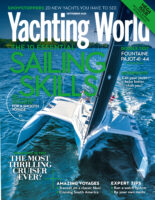Pip Hare celebrates a class win in Kinsale as she prepares for the next leg of the Shetland Round Britain & Ireland Race
Kinsale Harbour – in the sun with boat in bits around me.
My boat The Shed sailed across the finish line of the first leg of the Shetland Round Britain & Ireland two handed race, at 22.28.38 on Monday night.
First on the water in class 3 and first on handicap in our class as well. That will do!
What a first leg. It was a full-on sprint really. The distance from Plymouth to Kinsale was so short the strategy for this leg seemed plain. Push hard and don’t give up until you hit the finish line, and that is what we did.
After a wet and wild afternoon with the spinnaker, the wind eased as expected and we had sailed ourselves into a position where we would be reaching in the lighter airs to the finish. The hope being we would be able to make good speed in the light airs close reaching with the spinnaker or the code zero.
The tactic seemed good but as we neared the shore, there was still no sight of any of our class. I was gripped by the immediate fear that splitting from the pack and doing our own thing had not been a good idea.
Visibility was terrible for the whole day, in the persistent rain, but all the competitors in this race are fitted with an AIS transponder sending out notification of your position, course and heading every minute or so.
Depending on where you’re the Ariel is sited you are able to pick up information about boats up to about 3 miles away. I am finding this to be a major distraction.
Every few minutes I will pop down to the computer and have a look at who is around and how fast they are going. The programme is mesmerising, which is not necessarily a good thing. Of course the information is valuable, you can see if similar boats are going faster than you, and in what direction they are travelling which will give you an idea to their route and performance.
However, I think it would be really easy to spend the whole day down below ‘virtual yachting’ concentrating on how fast and where your competitors are going, running routing software and playing with your polars, quite forgetting that there is a whole real world outside and the only person that will make your boat go fast is YOU.
30 miles out from the finish and there was still no sign of anyone, let alone our class. I started to worry but Phil very philosophically told me the dice were rolled, we just had to get on and go fast and find out the outcome in the end.
Eventually Fasttrack appeared on the computer first and then as the cloud cleared in real life. We were ahead by 2 miles.
The last time I saw Fasttrack had been leading the rest of the pack so we assumed and hoped that put us in first position.
There followed a tense few hours. Changing from the small spinnaker to the big spinnaker to the code zero, we ploughed on in a dwindling breeze, hoping to make it too the land before it died completely and hanging off every updated report on Fasttracks progress to see if they were gaining on us.
10 miles off and more boats appeared from the night, some broadcasting AIS data, others we did not pick up. Each one that appeared had us wondering if they were in our class.
2 miles from the line we had extended our lead and as the sun was setting did one last change from the code zero to the big spinnaker which sailed us over the line, and as we later found our to a first place.
Time to breathe out.
And now the bit in between. I have discovered the stopovers are as much a part of the race as the sailing. Phil and I planned a strategy, making and prioritising a job list, checking the whole boat from top to bottom, sleeping, loading up the boat with food and spares for the next two legs as we assume Barra may be difficult and preparing for the next leg.
The boat was drenched when we arrived, not a dry thing onboard, but we were met by Ian, one of the Blue NG team supporting us on the race. He bought with him the hoover, heater, dehumidifier, tools and a car. So we took him to the pub.
Today the sun is shining everything is on deck drying. Ian has taken our sail away and had it repaired, he has just bought the shopping and Phil and I are working on getting the boat shedshape for the next leg.
Around us are all the fleet, flags flying, engines running, the Forties and Figaros, neatly parked with sails on deck, down our end of the dock there is a little more mess, a sign of leaking boats and broken kit. There is happy industry, a sharing of tools, light-hearted banter and the odd beer floating around.
We are all friends again until we step on the water when no matter how relaxed the sailor, the competitive spirit will kick and we will sail to win.




